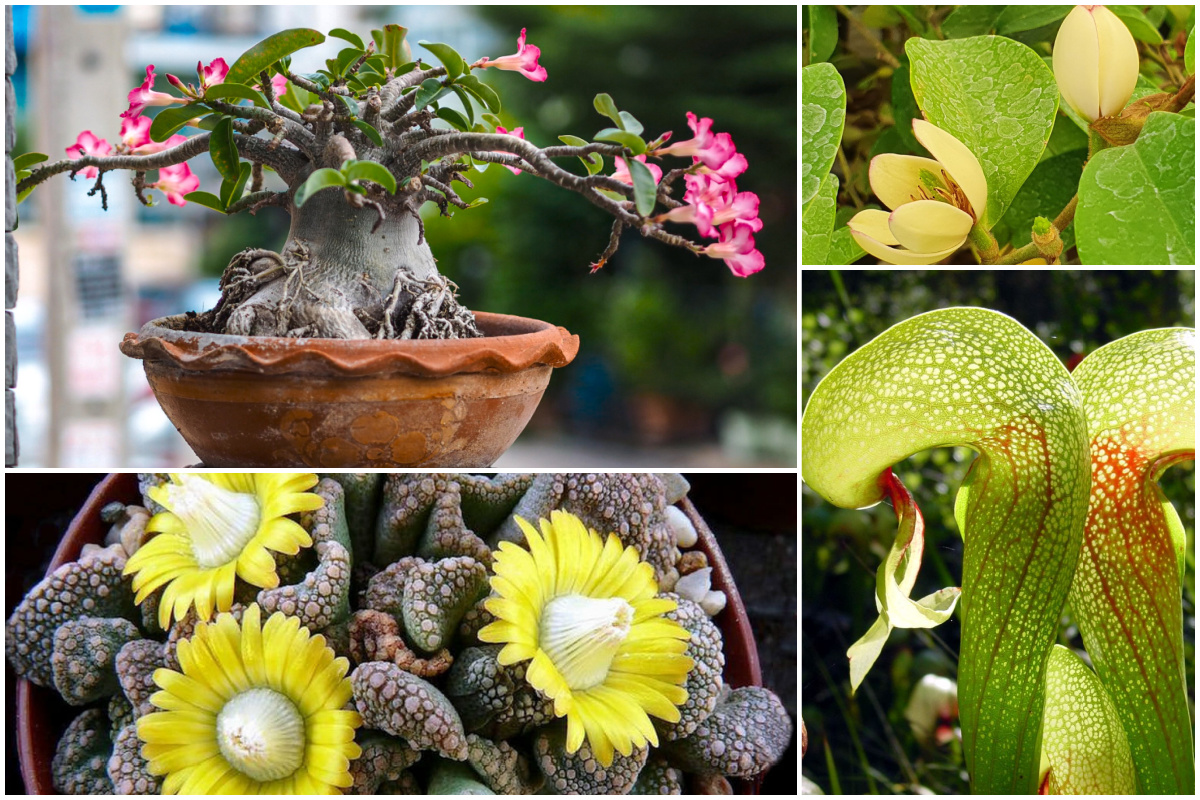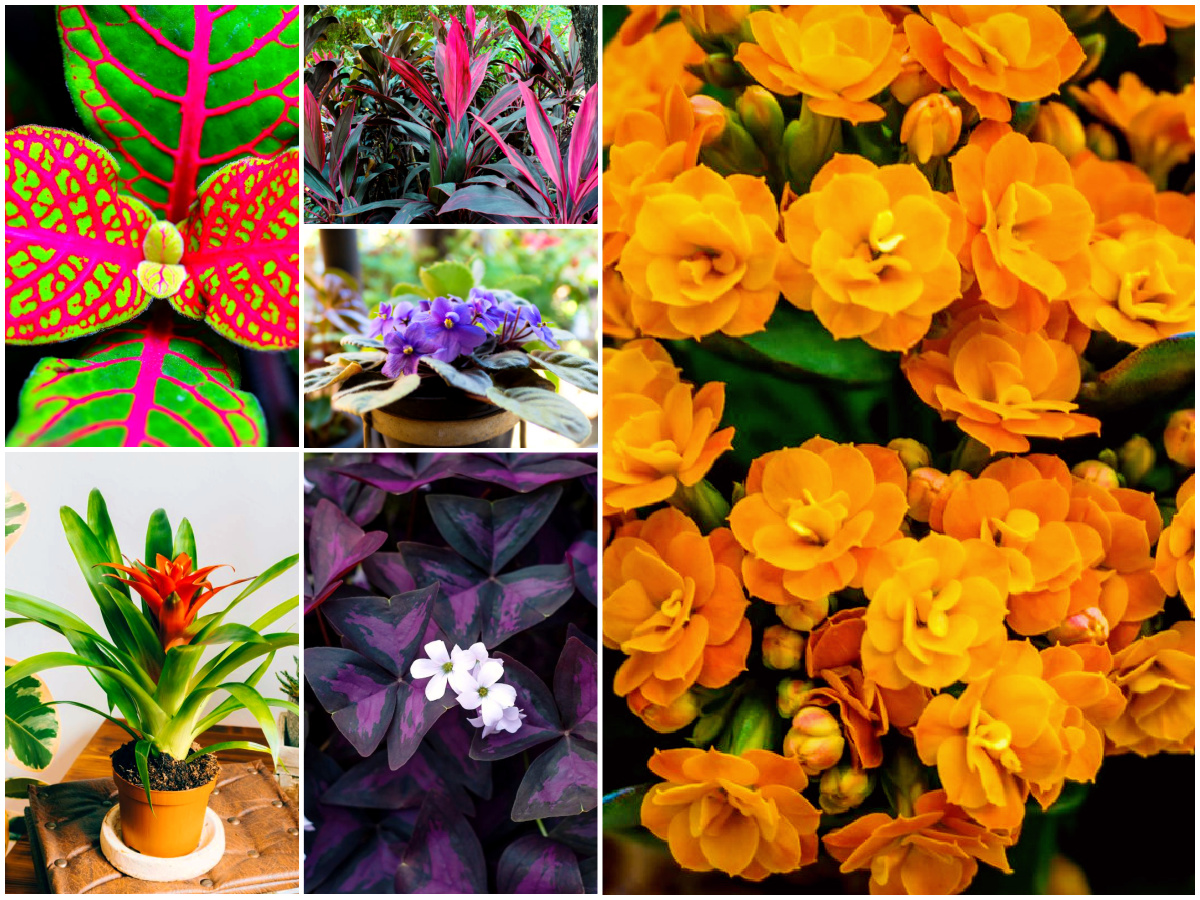The fiddle leaf fig (Ficus lyrata) is one of the most popular houseplants out there right now. Not surprising, since these indoor trees add a beautiful green touch to any interior! But what do you do if your fiddle leaf fig is not looking too happy?
Brown spots on fiddle leaf fig leaves are a common issue for houseplant enthusiasts to run into, as are black spots, leaf loss and droopiness. In order to nurse your fiddle leaf fig back to health, you’ll first have to diagnose the problem. That’s what this guide is for!
Let’s go into some of the common problems with fiddle leaf figs, their causes and what you can do to solve them and make sure it doesn’t happen again.
Tip: Before we get into this, I want to make clear that your houseplant is not always going to look like it did when you got it. Our indoor plants are grown under perfect conditions in nurseries and then they get dragged to the plant store and subsequently our homes. They don’t particularly like that.
Houseplants in general don’t like being moved. Fiddle leaf figs are especially finicky in the first few weeks after purchase. They might shed some of their leaves, but as long as you’re not seeing anything very disturbing happening, just leave your fiddle leaf fig alone for now. Hold off on repotting until next spring to avoid more trauma.
Additionally, you should keep in mind that houseplants almost always naturally shed their lower leaves to reveal a bare stem. Again, this is also normal unless it’s happening at a disturbing rate. Those bottom leaves just aren’t useful anymore, so the nutrients inside them are reabsorbed and the leaf crisps up, eventually dropping.
What I’m trying to say here is: Do not panic! That even applies if something more serious is going on. In many cases some adjustments will take care of the problem. If they don’t, well, at least you learned something!
Fiddle leaf fig brown spots
Problem: Leaves showing brown spotting
Causes: Root rot due to overwatering, infection, sunburn, underwatering, infestation, mechanical damage, nutrient imbalance
Brown spots on fiddle leaf fig leaves are unfortunately pretty common. Also unfortunate is that they can have different causes, so you’ll have to really evaluate the situation to pinpoint what’s going on here.
Brown spots on your fiddle leaf fig tree could be caused by the following:
Root rot
If you see nasty looking dark brown spots on your fiddle leaf fig, often starting around the edges or the base and appearing in a splotchy pattern, that can be an indication of root rot. Root rot is one of the more serious conditions that a houseplant can suffer from. You’ll have to take a peek at the roots as soon as you can.
If you see any blackness or mushy parts and especially if you note a nasty smell, your tree might be in trouble. Remove any afflicted roots and leaves and re-examine your watering schedule. After all, root rot will often be caused by overwatering.
Improper drainage can also be a big contributor to root rot. You should be using a nice loose medium rather than pure potting soil. Plenty of pine bark and perlite mixed in there really helps give the roots breathing room and the water space to flow out.
Bacterial infection
Annoyingly, brown spots on fiddle leaf fig leaves caused by bacterial infection can be similar to those caused by root rot. The differences are that root rot is often (though not always) most pronounced at the bottom of the plant rather than all over. Additionally, the coloration will be a lighter brown rather than almost black. You might also see yellowing spread to the whole leaf rather than concentrated splotches.
Bacterial infection is almost more difficult to combat than root rot. Remove any leaves that appear to have signs of it and try repotting your fiddle leaf fig. Make sure the soil and planter drain well.
Sunburn
Fiddle leaf figs are not opposed to a bit of sun, but things can sometimes get a bit too intense for them. This especially happens if you grow your plant outdoors or if it’s suddenly exposed to sharp sunlight after having been in a more shaded area before.
Sunburnt leaves are not too difficult to diagnose, although they can present differently depending how badly the burn was and how long it’s been since it happened. They range from an almost bleached look to yellow or light brown. Obviously, the issue will usually be concentrated in the upper leaf range, since those are the ones that get blasted the harshest.
There’s not much you can do about sunburn once it has happened. Place the plant in a more protected spot and introduce it more gradually to the sun if you do want to keep it in that lighter location. You can remove the damaged leaves, since they unfortunately won’t recover.
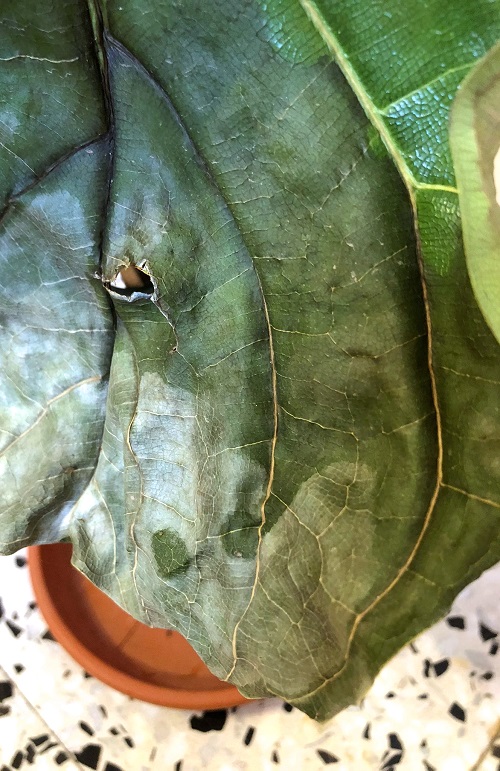
Underwatering
You might be seeing your fiddle leaf fig’s leaves slowly turning brown and crispy, starting from the edges and progressing until the leaf just falls off. This can be a sign of underwatering, especially if the problem is concentrated to the bottom of the plant.
If your watering schedule worked fine before, consider what has changed and adjust accordingly. The amount of water a plant needs is not the same all year round! Watering once a week is a good place to start but in the end it all depends on your home environment.
- Is it summertime? During the warm months, houseplants will be actively trying to grow and put out new growth, making the best of the higher temperatures and increased light. This means they also use up more water and can go dry startlingly quickly!
- Did you move your fiddle leaf fig to a lighter spot? Again, more light means more growth and that means you will probably have to water more than you were used to.
- Have you aerated the soil recently? One lesser known issue is that some soil types can compact around your plant’s roots, forming a dense ball that doesn’t let water through. Water always takes the path of the least resistance, so while you think you’re giving your fiddle leaf fig a nice drink, the moisture might actually just be flowing out past the edges of the planter.
It can help to regularly take a chopstick and gently poke it into the soil to loosen things up. If the soil was compacted you might want to repot your fiddle leaf fig into a looser mixture next spring.
Tip: Houseplants generally don’t like to be placed close to a heater. They also like a bit of moisture in the air. If the humidity is very low, you might want to run a humidifier.
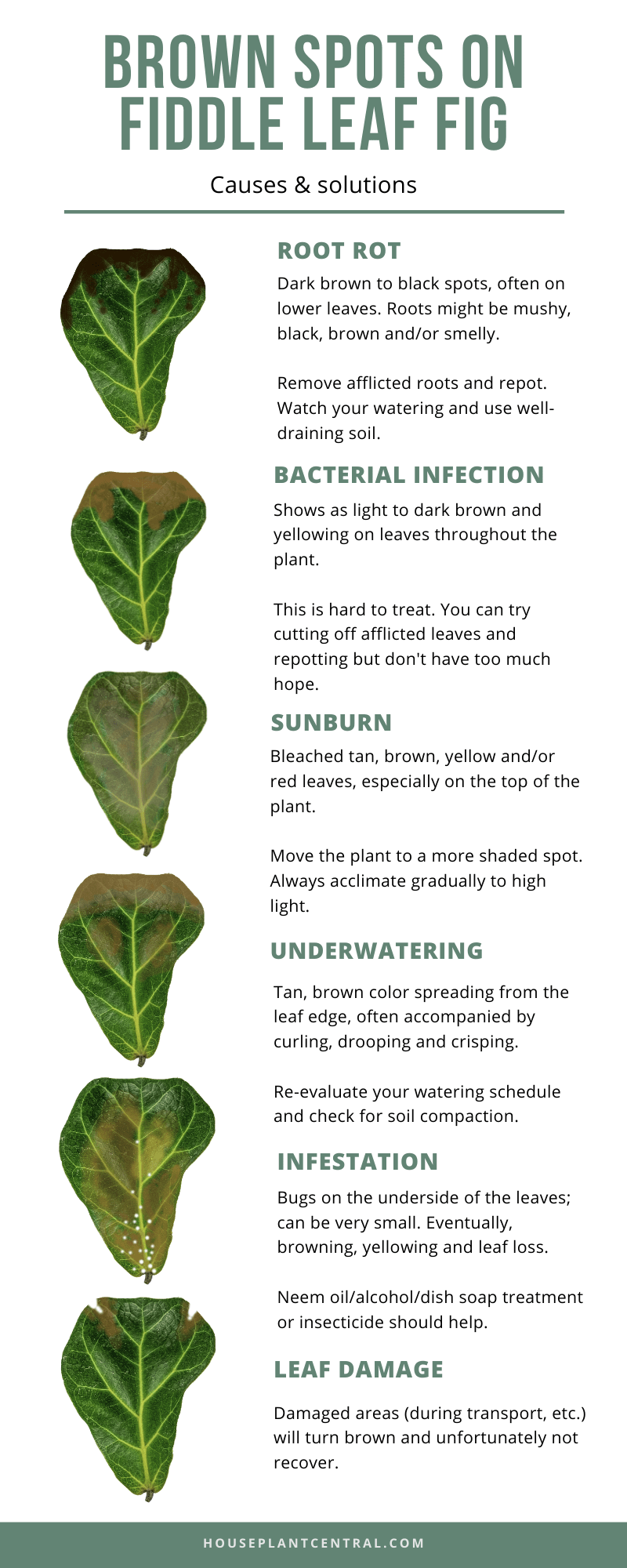
Infestation
In some cases, brown spots on your fiddle leaf fig tree can mean that your home contains some unwelcome visitors. Eek! One of the things you should always do if you see leaf browning is to check the underside of the leaves, since that’s where critters like to hide out. They survive by sucking the juices from your plant. Bad infestations can unfortunately be quite problematic.
There are various kinds of plant pests and some of them can be very small, so you might need a magnifying glass to make it easier to spot the culprits. A few common suspects include but are not limited to:
- Spider mites: these are so small they just look like moving little specks. What gives them away easily is the webbing they form on the underside of the leaf. They don’t like moisture, so check the humidity in your home and consider running a humidifier to prevent future issues with these guys after treatment.
- Mealybugs: possibly the most hated of all since they’re so darn persistent! They look like fuzzy little white spots that prefer the part of the plant where the leaf connects to the stem.
- Aphids: little green or black insects. I find these are especially common if your plant was outdoors for the summer.
- Fungus gnats: what you’ll see are little flies around your plant but the real problem is in the soil. Fungus gnat larvae love munching on plant roots, causing your plant to be unable to maintain its leaves. They love humidity and you can often combat them just by letting the soil dry more between waterings.
Other plant pests include thrips, whiteflies and scale. You might want to familiarize yourself a bit with all these so you can recognize them if need be.
So what should you do if you find bugs on the leaves of your fiddle leaf fig? There are plenty of home remedies to try. Using diluted neem oil can be quite effective. If you don’t have it on hand (yet), you can even just try a mixture of water and some dish soap. Check back every week or so to see if the infestation has returned or not. You can also consider a (natural) commercial insecticide.
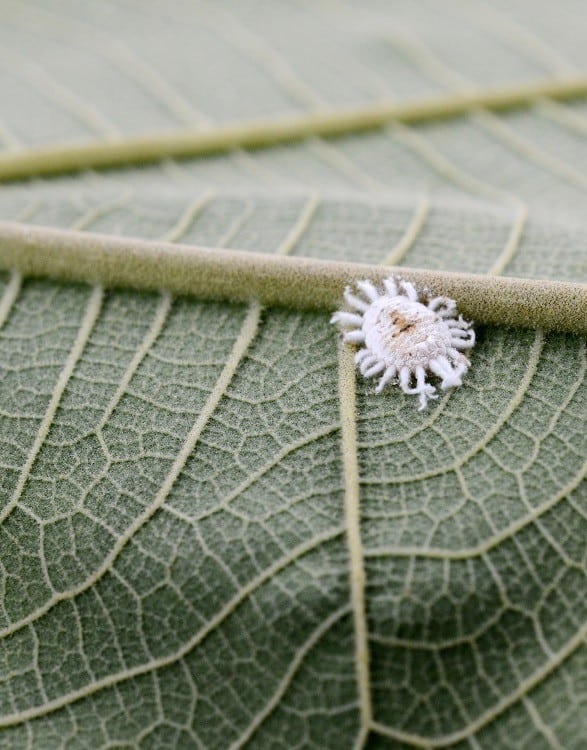
sumaetho on Adobe Stock.
Leaf damage
If your fiddle leaf fig was recently transported or moved around, its leaves might have sustained some damage in the process. Unfortunately, plant leaves don’t recover once they’re damaged. They may not fall off, but wear and tear will remain visible!
Scrapes and nicks on your fiddle leaf fig’s leaves will often be accompanied by a bit of browning around the affected area. Annoying, but there’s not much you can do.
Some prefer to remove the damaged leaf for aesthetic purposes, but I like to leave them on there. This way, my plant can later reabsorb the nutrients from them when it’s time for them to go naturally.
Fertilizer burn
Fiddle leaf figs are big plants and big plants like a bit of fertilizer during the growing months. However, over-fertilizing or applying plant food at the wrong time can also lead to brown spots on the leaves: fertilizer burn.
If you think your fiddle leaf fig might be showing some fertilizer burn or if you just realized you made a mistake with the plant food, flushing the soil with distilled water should help. Be sure not to use fertilizer during the winter months nor directly after repotting. The plant won’t be actively growing and can’t use the extra nutrients.
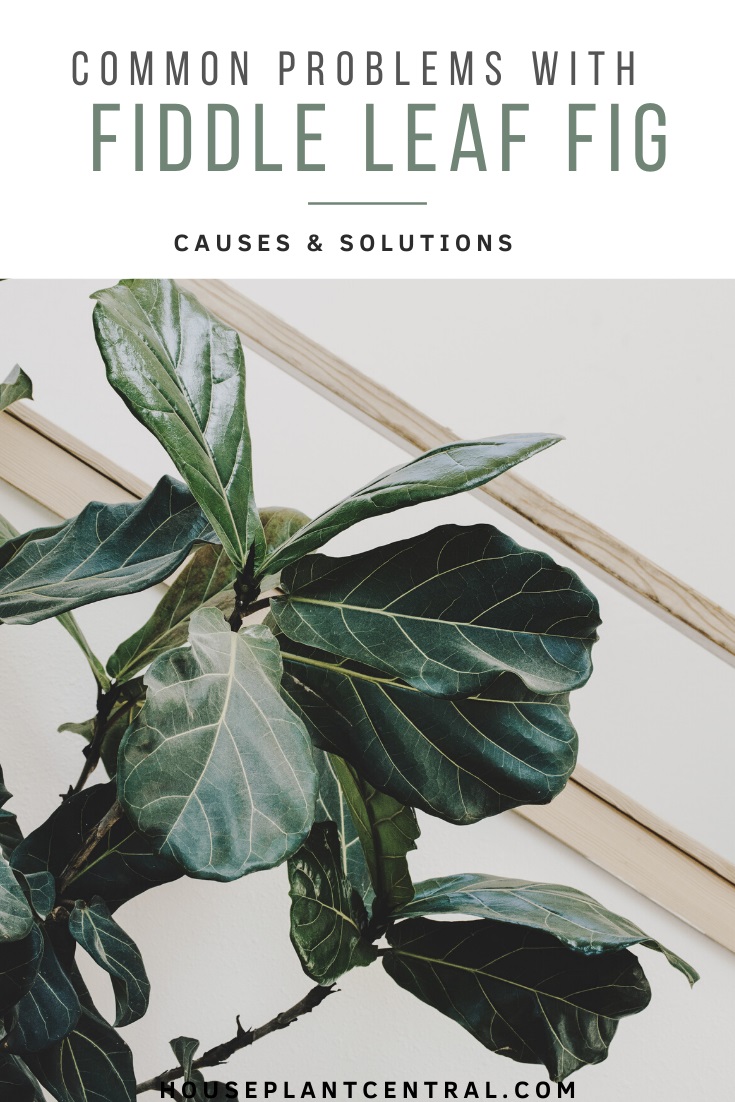
Black spots on fiddle leaf fig
Problem: Leaves developing black spots
Causes: Root rot, infection (overwatering)
If you’re seeing black spots on your fiddle leaf fig’s leaves (as well as possible brown spotting and leaf loss), that might be a sign you’ve been watering the plant too much.
Classic root rot
As discussed in the section on brown leaf spots, overwatering your fiddle leaf fig can cause root rot. This is a serious issue that should be dealt with as soon as possible. Removing the afflicted roots, repotting into well-draining soil and ensuring you’re not overwatering are crucial.
Root rot can be caused by different pathogens, many of which fungal. You can consider using a root-fortifying product to help care for your fiddle leaf fig’s roots.
Fungal infection
Fungal infections can also cause localized black spots on fiddle leaf figs. This can be recognized from the fact that the spots often show up right in the middle of the leaf rather than classic root rot-related decay on the edges.
There are several different types of fungi out there that can attack our houseplants and none of them are good news. You need to isolate the plant, remove all afflicted leaves and start a fungicide regimen as soon as you can.
Bacterial infection
Lastly, we’re back to bacterial infection, which was also discussed in the section on brown leaves. Bacterial issues can cause both brown and black spots on your fiddle leaf fig. Unfortunately, they can be serious. Although some bacterial infections just cause localized lesions, others can quickly ravage a whole plant.
There isn’t always too much you can do about bacterial infections. Again, remove damaged leaves. Get your nose down close to the soil and smell it. If it’s nasty (sorry for making you take a whiff!) definitely repot into a more well-draining soil. Make sure you’re not watering the plant too heavily.
Tip: In addition to from bad drainage and too much water, low light conditions also increase the chances of rot, fungal problems and bacterial infections taking hold. Fiddle leaf figs need bright light to be able to use the water you provide effectively and to thrive.
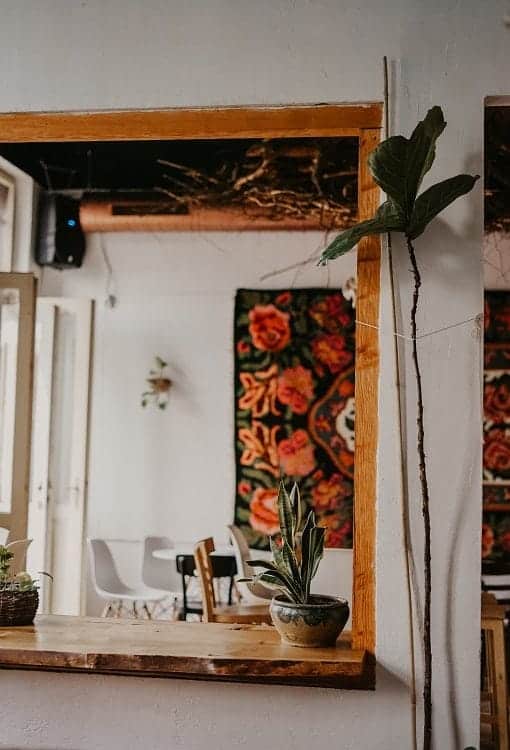
Fiddle leaf fig dropping leaves
Problem: Foliage loss
Causes: Shock, lack of moisture, location, overwatering
If your fiddle leaf fig is losing leaves that turned brown or black before they fell off, scroll up to go to the section on problems with leaf browning or blackening. If they’re just dropping after having started to droop or are falling off while they still look completely healthy, stay here.
- Shock: The most common cause for fiddle leaf fig leaf drop. As mentioned at the start of this article, no houseplant likes to be moved and fiddle leaf figs are particularly fussy about it. If you just bought or moved yours and it’s shedding, give it a few weeks before you start freaking out.
- Lack of moisture: If your plant’s leaves appear to be drooping and/or crisping before dropping, that indicates a moisture-related issue. Is it possible you’re underwatering? If you’re not, could the humidity in your home just be very low? You might need to run a humidifier.
- Location: Did you choose an unfortunate spot for your fiddle leaf fig? They don’t like darkness, nor do they like being near a heater or A/C. Drafts and spots prone to temperature swings are not appreciated either.
- Overwatering: This is generally associated with significant yellowing, browning or blackening of the leaves before they drop.

Fiddle leaf fig leaves drooping
Problem: Plant looks wilted
Causes: Overwatering, underwatering, soil compaction
If your fiddle leaf fig is showing droopy leaves that are turning yellow or brown as well, that’s a sure sign you’re likely watering too much for the amount of light the plant is getting.
If the plant is just droopy and possibly a bit crispy, chances are higher you’re actually underwatering. This can also lead to crispy brown leaf edges but doesn’t always present like that. If you suspect underwatering, check the plant more often. If you stick a finger in the soil, you should feel some slight humidity, though never wetness.
Do you feel like you’ve been watering enough, but still see these symptoms? There are some potential causes:
- As mentioned before, you can accidentally underwater if your plant is in a lighter location than usual (either due to it having been moved or summer starting).
- The soil might have clumped around the roots and made them unable to reach the water, so don’t forget to aerate regularly by loosening it gently using a chopstick.
- Terracotta planters are porous and breathe out moisture through their walls, which can be an advantage. However, it can also lead to your fiddle leaf fig drying out quickly if it’s in a very sunny spot (which it ideally should be!).
Tip: Some drooping immediately after repotting your fiddle leaf fig is normal. You broke a lot of its precious hair roots, so it’s not able to take up water as well. It should be fine after sulking for a week or so.
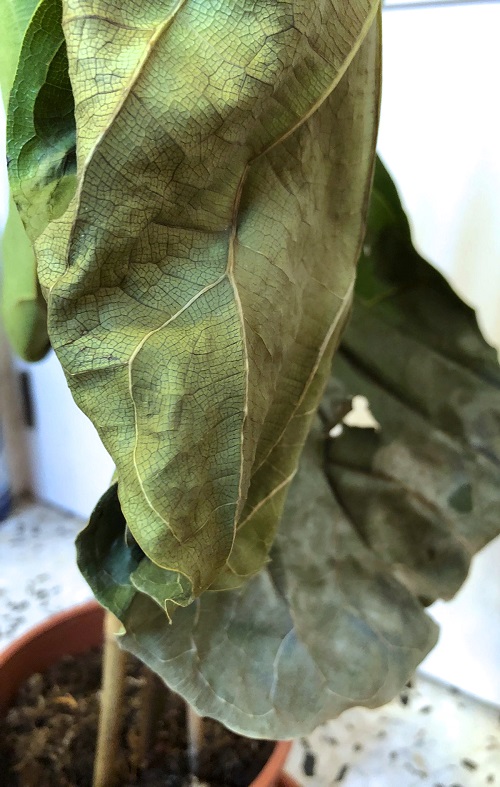
Fiddle leaf fig yellow leaves
Problem: Foliage is yellowing
Causes: Overwatering, lack of light, lack of nutrients
As with brown leaves on your fiddle leaf fig, yellowing can have many causes, making it somewhat difficult to pinpoint the actual problem. As always, you’ll have to just meticulously go over the care you’re providing to see where something is going wrong.
- First off, the common suspect: are you overwatering? Soggy soil and improper drainage can cause yellowing, browning and also blackening once root rot sets in.
- Is your fiddle leaf fig receiving enough light? Lack of that lifegiving sunny goodness can turn this indoor tree into a sad shell of a plant with pale yellow leaves, lack of new growth, leaf drop and pretty much everything else that can go wrong. It’s pretty hard to give this one too much light indoors as long as you acclimate it properly. It wants all the sun you can give it!
- If your fiddle leaf fig is in a nice, bright spot and your watering schedule seems spot on, consider how long it’s been since you last gave the plant some food. It might need some fertilizer, especially if it’s been a while since you’ve last repotted. Fresh soil usually contains nutrients but once those are all used up, a fiddle leaf fig fertilizer is the way to go.
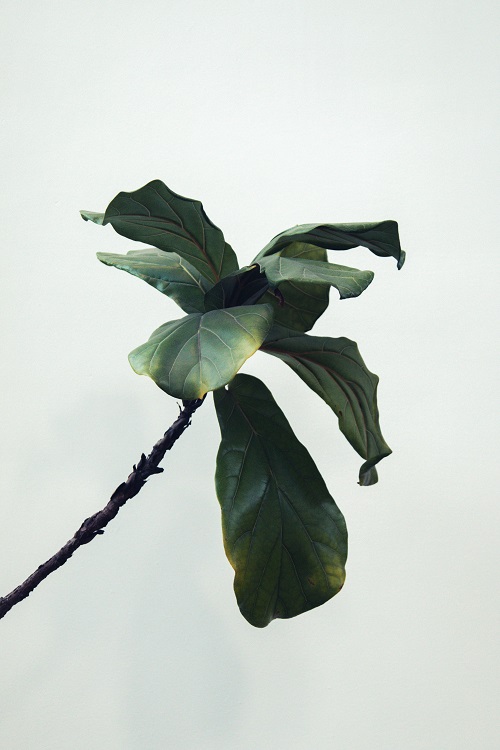
Fiddle leaf fig leaves curling
Problem: Leaves curling inwards or outwards
Causes: Overwatering, underwatering, low humidity, root disturbance
Curling on your fiddle leaf fig’s leaves is common and usually not too worrisome, especially if the plant bounces back after a few days. If it doesn’t, the possible culprits are generally the usual suspects: both under- and overwatering can cause this. Low humidity is also a common cause for leaf curl.
If you see curling or wonkiness on a single new leaf, the plant’s roots may have been disturbed somehow. The most common cause is repotting.
Red spots on fiddle leaf fig
Problem: Red dots on leaves
Causes: Normal, edema
Are your fiddle leaf fig’s leaves covered in little red spots? The most common cause for this is oedema, which can plague all houseplants. Basically, if a plant’s roots take up more water than it can actually handle, the cells in the leaves burst. This leaves those tell-tale red spots (or dead, blister-like spots).
Mild oedema in your fiddle leaf fig is not really much to worry about. It’s unsightly, yes, but sometimes blemishes just happen! Reddish dotting on new leaves is very common in fiddle leaf figs and as the leaves darken they won’t seem so prominent.
If oedema seems pretty severe and keeps popping up, you might need to take a peek at your watering habits. Erratic watering is a prime cause for moisture stress and, in turn, oedema. Do you maybe tend to let the plant dry just a tad too much before watering again?
Although oedema is the most common cause for red spots on fiddle leaf figs, it’s important to check the underside of the leaves as well. Spider mites, a pest discussed briefly in the section on infestation, can also cause blemishes with this appearance.
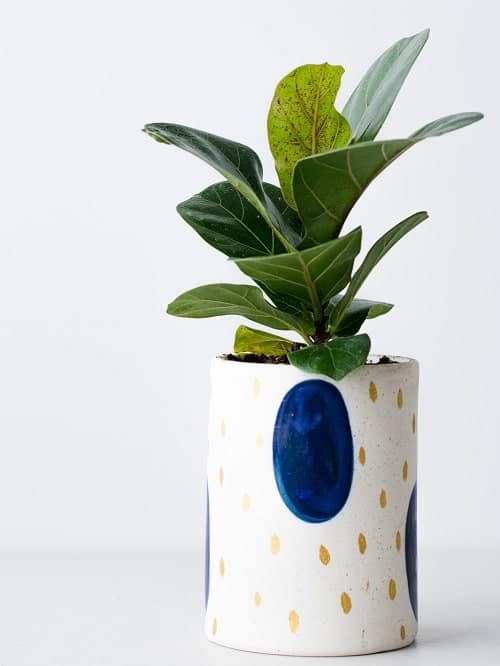
With all this being said, I have to mention that fiddle leaf figs aren’t the easiest indoor trees out there. Don’t feel bad if you didn’t have success with yours. Not all plants work in all homes, as there are many factors that influence houseplant health. Why not consider a similar but somewhat less fussy species in the Ficus genus, like the rubber plant?
Infographic leaf photo © Phubes on Adobe stock.


